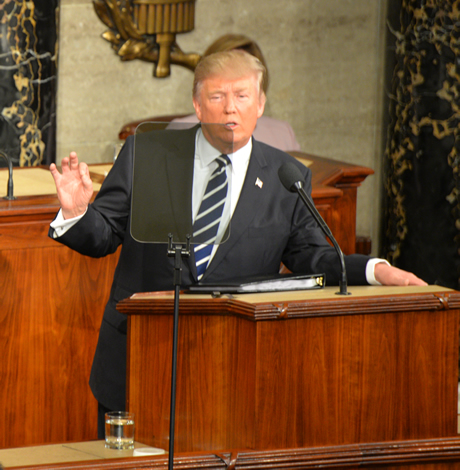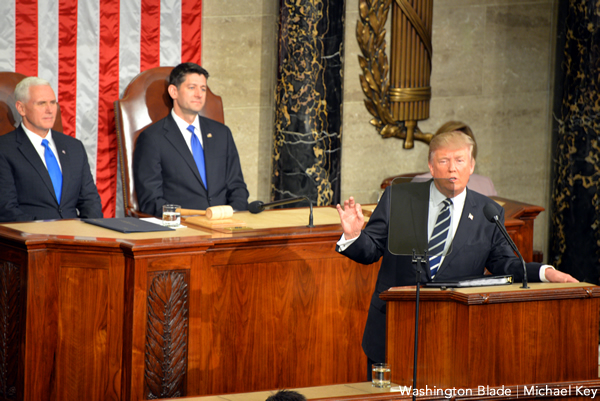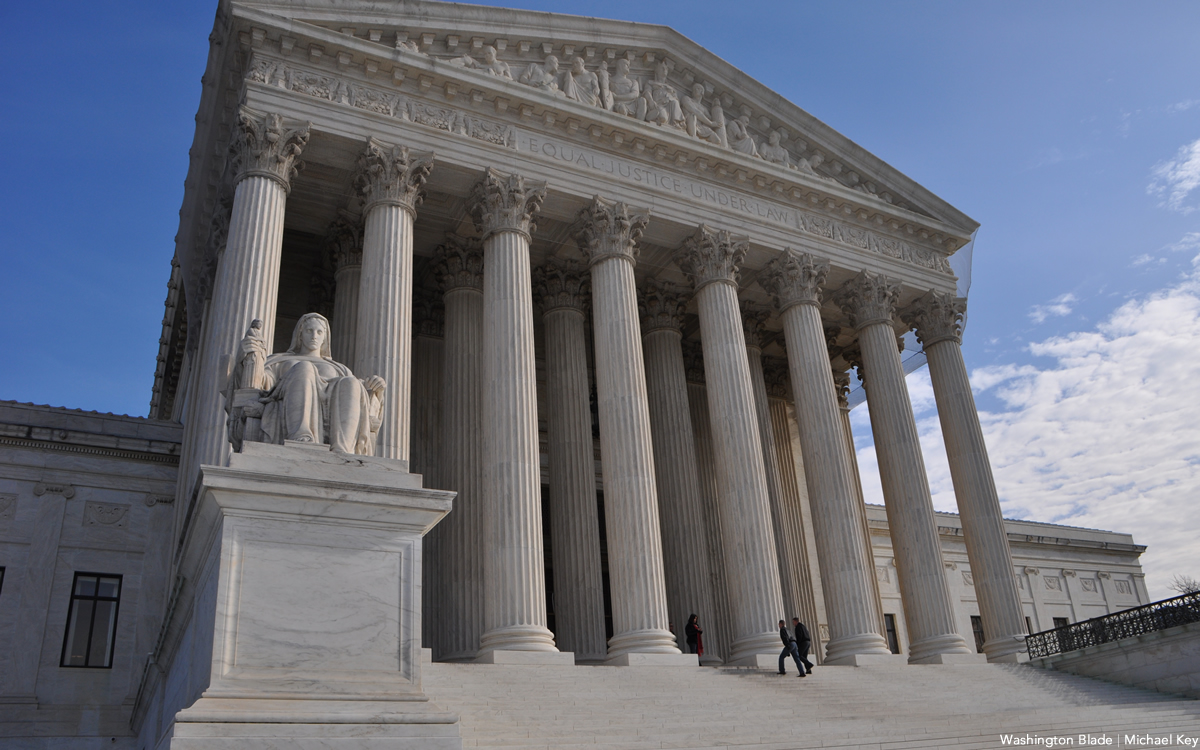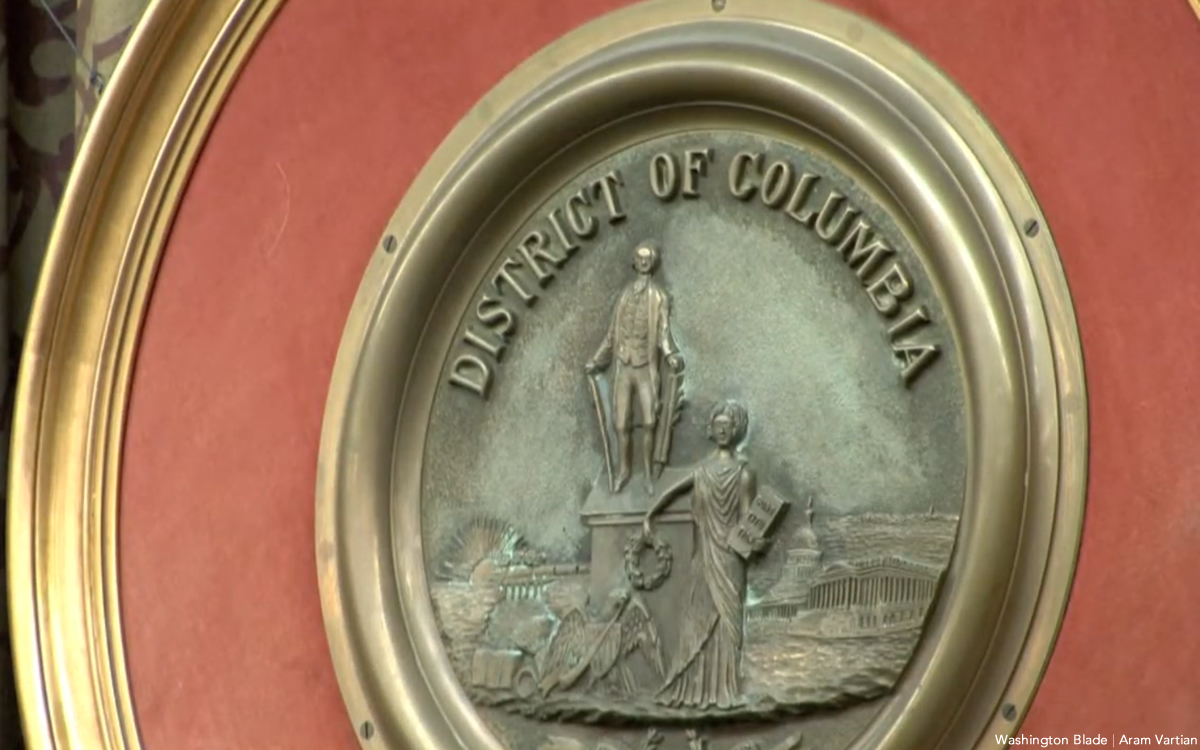Opinions
Trump’s motorized iceberg
A weak, unstable president imperils the nation and the world


President Donald Trump addresses a Joint Session of Congress on Feb. 28, 2017. (Washington Blade photo by Michael Key)
Dissent is patriotic, especially when your fellow citizens are being herded off a cliff. Remember this the next time the pundits go soft over the mad grifter in the Oval Office.
To say Trump’s cracks are showing is like leaning over a boat rail and saying, “I see water.” The cracks are so many, they look like part of the ship design. The frequent Republican standing ovations during his big speech last week, and raves over how presidential he was for not drooling, are as reassuring as a blind lookout. You won’t be singing “Nearer My God to Thee” when you’re searching for a door to float on. Before they’re done, the Trumpists and their enablers will try to take the rest of us with them. They are a motorized iceberg chasing down ships.
Immediately after his mendacious address to Congress, Trump was lionized as if reading from a TelePrompTer for an hour without foaming at the mouth made him Abe Lincoln. Then his attorney general crapped all over his sunny headlines, and he ended the week by grounding top aides as he flew off to Mar-a-Lago in a rage.
We do our country no favors by politely forgetting that our so-called president and his allies traffic routinely in boldfaced lies: The assumption that Muslims are terrorists. The claim that Mexicans are streaming across our southern border. The howler that refugees get no vetting. The delusion that robbing women of reproductive choice will lead to fewer abortions. The fabrication about millions of illegal voters. The hyperventilating over inflated crime stats and imaginary transgender villainy in bathrooms while privileged predators float above the law.
When those targeted by these lies are attacked and killed, the slanderers either mouth boilerplate or give us blank looks. How dare we hold them responsible for what they are constantly fomenting?
Trump’s fellow partisans are despoiling our environment, endangering public health and safety, trashing basic liberties, and tearing families apart. They are taking sledgehammers to the pillars of our republic. How can we expect to win over those cheering this by calmly explaining that they are going against their own interests?
When Jewish cemeteries are vandalized and South Asians are shot just for existing, we are horrified and ask how people could do this. But intolerance has always been with us. What unleashed it lately was Trump’s hate-filled campaign, which gave license to people’s worst impulses. We cannot reason with the beast. We must force it back into its lair and drive from power those who feed it and treat it like a pet.
The drip drip drip of Russiagate, with the quickly abandoned denials and Trump’s “So are you” schoolyard ripostes, has become darkly comical. His staff appear to be communicating with him via press leaks.
On March 4, citing no evidence, Trump accused his predecessor of wiretapping Trump Tower in New York last fall. His blunder was not that he showed his typical reckless disregard for the truth, but that by trying to deflect suspicion onto Mr. Obama, he only fueled demands for a probe of his own evident collusion with the Russians.
Citizen protests and pressure are having their effect. Hiding from constituents is no more a sign of strength than releasing a healthcare replacement bill without a score from the Congressional Budget Office. The promise of better healthcare at lower cost is fanciful. The provision to strip all federal funding from Planned Parenthood will by itself endanger the healthcare of millions. We will see if the prospect of career suicide concentrates legislative minds.
Here’s a safe bet: Trump will start a war with the threefold purpose of lifting his poll numbers, silencing his critics, and increasing military spending. It is unclear how he thinks crippling the State Department will help any war effort; but Trump regards study as weakness. His hawkish overcompensation for his five draft deferments will be ruinous; yet the debacle will be deemed such a success that even if he sets off a nuclear exchange and survives, he will hold a victory rally amid the rubble.
If that is not your vision of paradise, then #StayWoke and #Resist in any way you can. Dissent is both patriotic and humane.
Richard J. Rosendall is a writer and activist. He can be reached at [email protected].
Copyright © 2017 by Richard J. Rosendall. All rights reserved.
Opinions
New research shows coming out is still risky
A time of profound psychological vulnerability

Coming out is often celebrated as a joyful milestone – a moment of truth, pride, and liberation. For many LGBTQ+ people, that’s exactly what it becomes. But new research I co-authored, published in the journal Pediatrics this month, shows that the period surrounding a young person’s first disclosure of their sexual identity is also a time of profound psychological vulnerability. It’s a fragile window we are not adequately protecting.
Using data from a national sample of lesbian, gay, and bisexual people, our study examined what happens in the years before and after someone comes out to a family member or a straight friend. We weren’t looking at broad lifetime trends or comparing LGBTQ+ youth to heterosexual peers. Instead, we looked within each person’s life. We wanted to understand how their own suicide risk changed around the moment they first disclosed who they are.
The results were unmistakable. In the year a person came out, their likelihood of having suicidal thoughts, developing a suicide plan, or attempting suicide increased sharply. Those increases were not small. Suicide planning rose by 10 to 12 percentage points. Suicide attempts increased by 6 percentage points. And the elevated risk didn’t fade quickly. It continued in the years that followed.
I want to be very clear about what these results mean: coming out itself is not the cause of suicidality. The act of disclosure does not harm young people. What harms them is the fear of rejection, the stress of navigating relationships that suddenly feel uncertain, and the emotional fallout when people they love respond with confusion, disapproval, or hostility.
In other words, young LGBTQ+ people are not inherently vulnerable. We make them vulnerable.
And this is happening even as our culture has grown more affirming, at least on the surface. One of the most surprising findings in our study was that younger generations showed larger increases in suicide risk around coming out compared to older generations. These are young people who grew up with marriage equality, LGBTQ+ celebrities, Pride flags in classrooms, and messaging that “it gets better.”
So why are they struggling more?
I think it’s, in part, because expectations have changed. When a young person grows up hearing that their community is increasingly accepted, they may expect support from family and friends. When that support does not come, or comes with hesitation, discomfort, or mixed messages, the disappointment is often devastating. Visibility without security can intensify vulnerability.
Compounding this vulnerability is the broader political environment. Over the last several years, LGBTQ+ youth have watched adults in positions of power debate their legitimacy, restrict their rights, and question their place in schools, sports, and even their own families. While our study did not analyze political factors directly, it is impossible to separate individual experiences from a climate that routinely targets LGBTQ+ young people in legislative hearings, news cycles, and social media.
When you’re 14 or 15 years old and deciding who to tell about your identity, the world around you matters.
But the most important takeaway from our study is this: support is important. The presence, or absence of family acceptance is typically one of the strongest predictors of whether young people thrive after coming out. Research consistently shows that when parents respond with love, curiosity, and affirmation, young people experience better mental health, stronger resilience, and lower suicide risk. When families reject their children, the consequences can be life-threatening.
Support doesn’t require perfect language or expertise. It requires listening. It requires pausing before reacting out of fear or unfamiliarity. It requires recognizing that a young person coming out is not asking you to change everything about your beliefs. They’re asking you to hold them through one of the most vulnerable moments of their life.
Schools, too, have an enormous role to play. LGBTQ+-inclusive curricula, student groups, and clear protections against harassment create safer environments for disclosure.
Health care settings must also do better. Providers should routinely screen for mental health needs among LGBTQ+ youth, especially around the time of identity disclosure, and offer culturally competent care.
And as a community, we need to tell a more honest story about coming out. Yes, it can be liberating. Yes, it can be beautiful. But it can also be terrifying. Instead of pretending it’s always a rainbow-filled rite of passage, we must acknowledge its risks and surround young people with the support they deserve.
Coming out should not be a crisis moment. It should not be a turning point toward despair. If anything, it should be the beginning of a young person’s journey toward authenticity and joy.
That future is possible. But it depends on all of us – parents, educators, clinicians, policymakers, and LGBTQ+ adults ourselves – committing to make acceptance a daily practice.
Young LGBTQ+ people are watching. And in the moment they need us most, they must not fall into silence or struggle alone.
Harry Barbee, Ph.D., is an assistant professor at the Johns Hopkins Bloomberg School of Public Health. Their research and teaching focus on LGBTQ+ health, aging, and public policy.
Letter-to-the-Editor
Candidates should pledge to nominate LGBTQ judge to Supreme Court
Presidential, Senate hopefuls need to go on the record

As soon as the final votes are cast and counted and verified after the November 2026 elections are over, the 2028 presidential cycle will begin in earnest. Polls, financial aid requests, and volunteer opportunities ad infinitum will flood the public and personal media. There will be more issues than candidates in both parties. The rending of garments and mudslinging will be both interesting and maybe even amusing as citizens will watch how candidates react to each and every issue of the day.
There is one particular item that I am hoping each candidate will be asked whether in private or in public. If a Supreme Court vacancy occurs in your potential administration, will you nominate an open and qualified LGBTQ to join the remaining eight?
Other interest groups on both sides have made similar demands over the years and have had them honored. Is it not time that our voices are raised as well? There are several already sitting judges on both state and federal benches that have either been elected statewide or approved by the U.S. Senate.
Our communities are being utilized and abused on judicial menus. Enough already! Challenge each and every candidate, regardless of their party with our honest question and see if honest answers are given. By the way … no harm in asking the one-third of the U.S. Senate candidates too who will be on ballots. Looking forward to any candidate tap dancing!
Opinions
2026 elections will bring major changes to D.C. government
Mayor’s office, multiple Council seats up for grabs

Next year will be a banner year for elections in D.C. The mayor announced she will not run. Two Council members, Anita Bonds, At-large, and Brianne Nadeau, Ward 1, have announced they will not run. Waiting for Del. Norton to do the same, but even if she doesn’t, there will be a real race for that office.
So far, Robert White, Council member at-large, and Brooke Pinto, Council member Ward 2, are among a host of others, who have announced. If one of these Council members should win, there would be a special election for their seat. If Kenyon McDuffie, Council member at-large, announces for mayor as a Democrat, which he is expected to do, he will have to resign his seat on the Council as he fills one of the non-Democratic seats there. Janeese George, Ward 4 Council member, announced she is running for mayor. Should she win, there would be a special election for her seat. Another special election could happen if Trayon White, Ward 8, is convicted of his alleged crimes, when he is brought to trial in January. Both the Council chair, and attorney general, have announced they are seeking reelection, along with a host of other offices that will be on the ballot.
Many of the races could look like the one in Ward 1 where at least six people have already announced. They include three members of the LGBTQ community. It seems the current leader in that race is Jackie Reyes Yanes, a Latina activist, not a member of the LGBTQ community, who worked for Mayor Fenty as head of the Latino Affairs Office, and for Mayor Bowser as head of the Office of Community Affairs. About eight, including the two Council members, have already announced they are running for the delegate seat.
I am often asked by candidates for an endorsement. The reason being my years as a community, LGBTQ, and Democratic, activist; and my ability to endorse in my column in the Washington Blade. The only candidate I endorsed so far is Phil Mendelson, for Council chair. While he and I don’t always agree on everything, he’s a staunch supporter of the LGBTQ community, a rational person, and we need someone with a steady hand if there really are six new Council members, out of the 13.
When candidates call, they realize I am a policy wonk. My unsolicited advice to all candidates is: Do more than talk in generalities, be specific and honest as to what you think you can do, if elected. Candidates running for a legislative office, should talk about what bills they will support, and then what new ones they will introduce. What are the first three things you will focus on for your constituents, if elected. If you are running against an incumbent, what do you think you can do differently than the person you hope to replace? For any new policies and programs you propose, if there is a cost, let constituents know how you intend to pay for them. Take the time to learn the city budget, and how money is currently being spent. The more information you have at your fingertips, the smarter you sound, and voters respect that, at least many do. If you are running for mayor, you need to develop a full platform, covering all the issues the city will face, something I have helped a number of previous mayors do. The next mayor will continue to have to deal with the felon in the White House. He/she/they will have to ensure he doesn’t try to eliminate home rule. The next mayor will have to understand how to walk a similar tightrope Mayor Bowser has balanced so effectively.
Currently, the District provides lots of public money to candidates. If you decide to take it, know the details. The city makes it too easy to get. But while it is available, take advantage of it. One new variable in this election is the implementation of rank-choice voting. It will impact how you campaign. If you attack another candidate, you may not be the second, or even third, choice, of their strongest supporters.
Each candidate needs a website. Aside from asking for donations and volunteers, it should have a robust issues section, biography, endorsements, and news. One example I share with candidates is my friend Zach Wahls’s website. He is running for United States Senate from Iowa. It is a comprehensive site, easy to navigate, with concise language, and great pictures. One thing to remember is that D.C. is overwhelmingly Democratic. Chances are the winner of the Democratic primary will win the general election.
Potential candidates should read the DCBOE calendar. Petitions will be available at the Board of Elections on Jan. 23, with the primary on June 16th, and general election on Nov. 3. So, ready, set, go!
Peter Rosenstein is a longtime LGBTQ rights and Democratic Party activist.



















